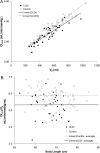Growth of lung parenchyma in infants and toddlers with chronic lung disease of infancy
- PMID: 20133928
- PMCID: PMC2874450
- DOI: 10.1164/rccm.200908-1190OC
Growth of lung parenchyma in infants and toddlers with chronic lung disease of infancy
Abstract
Rationale: The clinical pathology describing infants with chronic lung disease of infancy (CLDI) has been limited and obtained primarily from infants with severe lung disease, who either died or required lung biopsy. As lung tissue from clinically stable outpatients is not available, physiological measurements offer the potential to increase our understanding of the pulmonary pathophysiology of this disease.
Objectives: We hypothesized that if premature birth and the development of CLDI result in disruption of alveolar development, then infants and toddlers with CLDI would have a lower pulmonary diffusing capacity relative to their alveolar volume compared with full-term control subjects.
Methods: We measured pulmonary diffusing capacity and alveolar volume, using a single breath-hold maneuver at elevated lung volume. Subjects with chronic lung disease of infancy (23-29 wk of gestation; n = 39) were compared with full-term control subjects (n = 61) at corrected ages of 11.6 (4.8-17.0) and 13.6 (3.2-33) months, respectively.
Measurements and main results: Alveolar volume and pulmonary diffusing capacity increased with increasing body length for both groups. After adjusting for body length, subjects with CLDI had significantly lower pulmonary diffusing capacity (2.88 vs. 3.23 ml/min/mm Hg; P = 0.0004), but no difference in volume (545 vs. 555 ml; P = 0.58).
Conclusions: Infants and toddlers with CLDI have decreased pulmonary diffusing capacity, but normal alveolar volume. These physiological findings are consistent with the morphometric data obtained from subjects with severe lung disease, which suggests an impairment of alveolar development after very premature birth.
Figures



Similar articles
-
Membrane and Capillary Components of Lung Diffusion in Infants with Bronchopulmonary Dysplasia.Am J Respir Crit Care Med. 2016 Apr 1;193(7):767-71. doi: 10.1164/rccm.201506-1219OC. Am J Respir Crit Care Med. 2016. PMID: 26566056 Free PMC article.
-
Computed tomography score and pulmonary function in infants with chronic lung disease of infancy.Eur Respir J. 2011 Oct;38(4):918-23. doi: 10.1183/09031936.00172310. Epub 2011 Apr 8. Eur Respir J. 2011. PMID: 21478219 Free PMC article. Clinical Trial.
-
Quantitative assessment of chronic lung disease of infancy using computed tomography.Eur Respir J. 2012 Apr;39(4):992-9. doi: 10.1183/09031936.00064811. Epub 2011 Oct 17. Eur Respir J. 2012. PMID: 22005925 Free PMC article. Clinical Trial.
-
Assessment of inhibited alveolar-capillary membrane structural development and function in bronchopulmonary dysplasia.Birth Defects Res A Clin Mol Teratol. 2014 Mar;100(3):168-79. doi: 10.1002/bdra.23226. Epub 2014 Mar 6. Birth Defects Res A Clin Mol Teratol. 2014. PMID: 24604816 Free PMC article. Review.
-
Lung function tests in neonates and infants with chronic lung disease: forced expiratory maneuvers.Pediatr Pulmonol. 2006 Mar;41(3):199-214. doi: 10.1002/ppul.20320. Pediatr Pulmonol. 2006. PMID: 16288484 Review.
Cited by
-
Physiologic Pulmonary Phenotyping of Infants Born Preterm and Post-Discharge Respiratory Morbidity.J Pediatr. 2025 Apr;279:114475. doi: 10.1016/j.jpeds.2025.114475. Epub 2025 Jan 22. J Pediatr. 2025. PMID: 39855623 Free PMC article.
-
Progress in understanding the pathogenesis of BPD using the baboon and sheep models.Semin Perinatol. 2013 Apr;37(2):60-8. doi: 10.1053/j.semperi.2013.01.001. Semin Perinatol. 2013. PMID: 23582959 Free PMC article. Review.
-
Forced expiratory flows and diffusion capacity in infants born from mothers with pre-eclampsia.Pediatr Pulmonol. 2022 Oct;57(10):2481-2490. doi: 10.1002/ppul.26064. Epub 2022 Jul 14. Pediatr Pulmonol. 2022. PMID: 35796049 Free PMC article.
-
Nuclear factor-kappa-B signaling in lung development and disease: one pathway, numerous functions.Birth Defects Res A Clin Mol Teratol. 2014 Mar;100(3):202-16. doi: 10.1002/bdra.23233. Epub 2014 Mar 17. Birth Defects Res A Clin Mol Teratol. 2014. PMID: 24639404 Free PMC article. Review.
-
Inhaled Nitric Oxide Use and Outcomes in Critically Ill Children With a History of Prematurity.Respir Care. 2021 Oct;66(10):1549-1559. doi: 10.4187/respcare.08766. Respir Care. 2021. PMID: 34552014 Free PMC article.
References
-
- Baraldi E, Filippone M. Chronic lung disease after premature birth. N Engl J Med 2007;357:1946–1955. - PubMed
-
- Northway WH Jr, Rosan RC, Porter DY. Pulmonary disease following respirator therapy of hyaline-membrane disease. N Engl J Med 1967;267:357–368. - PubMed
-
- Jobe AJ. The new BPD: an arrest of lung development. Pediatr Res 1999;46:641–643. - PubMed
-
- Coalson JJ. Pathology of new bronchopulmonary dysplasia. Semin Neonatol 2003;8:73–81. - PubMed
-
- Husain AN, Siddiqui NH, Stocker JT. Pathology of arrested acinar development in postsurfactant bronchopulmonary dysplasia. Hum Pathol 1998;29:710–717. - PubMed
Publication types
MeSH terms
Grants and funding
LinkOut - more resources
Full Text Sources
Research Materials

